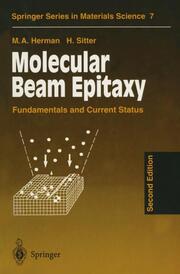Detailansicht
Molecular Beam Epitaxy
Fundamentals and Current Status, Springer Series in Materials Science 7
ISBN/EAN: 9783642800627
Umbreit-Nr.: 5653342
Sprache:
Englisch
Umfang: xiv, 453 S., 28 s/w Illustr., 25 farbige Illustr.,
Format in cm:
Einband:
kartoniertes Buch
Erschienen am 03.10.2013
Auflage: 2/2013
- Zusatztext
- Molecular Beam Epitaxy describes a technique in wide-spread use for the production of high-quality semiconductor devices. It discusses the most important aspects of the MBE apparatus, the physics and chemistry of the crystallization of various materials and device structures, and the characterization methods that relate the structural parameters of the grown (or growing) film or structure to the technologically relevant procedure. In this second edition two new fields have been added: crystallization of as-grown low-dimensional heterostructures, mainly quantum wires and quantum dots, and in-growth control of the MBE crystallization process of strained-layer structures. Out-of-date material has been removed.
- Kurztext
- Molecular Beam Epitaxy describes a technique in wide-spread use for the production of high-quality semiconductor devices. This monograph discusses the most important aspects of an MBE apparatus, the physics and chemistry of the crystallization of various materials and device structures, and the characterization methods that relate the structural para- meters of the grown (or growing) field or structure to the technologically relevant parameters of the crystallization procedure. In the present second edition two new fields of activity, which emerged in the 1990s have been addressed. These are: (i) crystallization of as-grown low-dimensional heterostructures, mainly quantum wires and quantum dots, and (ii) in-growth control of the MBE crystallization process of strained-layer structures in order to achieve the highly pre- ferred mode of crystallization, the perfect layer-by-layer growth. A substantial part of the "first edition text", which lost its present-day interest has been removed to have sufficiant space for the most current topics in MBE.
- Autorenportrait
- InhaltsangabeBackground Information.- 1. Introduction.- 1.1 Thin, Film Growth from Beams in a High Vacuum Environment.- 1.1.1 Vacuum Conditions for MBE.- 1.1.2 Basic Physical Processes in the MBE Vacuum Chamber.- 1.2 Evolution of the MBE Technique.- 1.2.1 Early Stages of MBE.- 1.2.2 MBE in the 1980s.- 1.2.3 MBE in the 1990s.- 1.3 Modifications of the MBE Technique.- 1.3.1 Gas Source MBE.- 1.3.2 Modulated-Beams MBE.- 1.3.3 FIBI-MBE Processing Technology.- 1.3.4 Guide to the MBE Literature.- Technological Equipment.- 2. Sources of Atomic and Molecular Beams.- 2.1 Effusion Process and the Ideal Effusion Cell.- 2.1.1 Langmuir and Knudsen Modes of Evaporation.- 2.1.2 Cosine Law of Effusion.- 2.2 Effusion from Real Effusion Cells.- 2.2.1 Near-Ideal Cylindrical Effusion Cell.- 2.2.2 Cylindrical Channel Effusion Cell.- 2.2.3 Hot-Wall Beam Cylindrical Source.- 2.2.4 Conical Effusion Cell.- 2.3 Effusion Cells Used in Solid Source MBE Systems.- 2.3.1 Conventional Effusion Cells.- 2.3.2 Dissociation (Cracker) Effusion Cells.- 2.3.3 Electron Beam and Laser Radiation Heated Sources.- 2.4 Beam Sources Used in GS MBE Systems.- 2.4.1 Arsine and Phosphine Gas Source Crackers.- 2.4.2 Gas Sources Used in MO MBE.- 3. High-Vacuum Growth and Processing Systems.- 3.1 Building Blocks of Modular MBE Systems.- 3.1.1 Cassette Entry Stage.- 3.1.2 Interstage Substrate Transfer System.- 3.1.3 Preparation and Analysis Stages.- 3.1.4 MBE Deposition Chamber.- 3.1.5 Beam Sources.- 3.1.6 Monitoring and Analytical Facilities.- 3.2 Multiple-Growth and Multiple-Process Facilities in MBE Systems.- 3.2.1 Hot-Wall Beam Epitaxy Growth System.- 3.2.2 Focused Ion Beam Technology.- Characterization Methods.- 4. Characterization Techniques.- 4.1 RHEED.- 4.1.1 Fundamentals of Electron Diffraction.- 4.1.2 Origin of RHEED Features.- 4.1.3 RHEED Data from Reconstructed Semiconductor Surfaces.- 4.1.4 RHEED Rocking Curves.- 4.1.5 RHEED Intensity Oscillations.- 4.1.6 Microprobe RHEED.- 4.2 Optical Characterization Techniques.- 4.2.1 Ellipsometry.- 4.2.2 Reflectance-Difference Spectroscopy.- 4.2.3 Laser Interferometry.- 4.3 Postgrowth Characterization Methods.- 4.3.1 Auger Electron Spectroscopy.- 4.3.2 X-ray Diffraction.- 4.3.3 Photoluminescence.- 4.3.4 Electrical Characterization.- 4.3.5 Scanning Probe Microscopy.- 4.3.6 Sophisticated Characterization Methods.- MBE Growth Process.- 5. MBE Growth Processes of Lattice-Matched Structures.- 5.1 General View of the MBE Growth Process.- 5.1.1 Equilibrium States in MBE.- 5.1.2 Relations Between Substrate and Epilayer.- 5.2 Growth Mechanisms in Lattice-Matched MBE.- 5.2.1 Growth on Nominally-Oriented Substrates.- 5.2.2 Growth on Vicinal Surfaces.- 5.2.3 Growth Interruption Effects.- 5.3 Modulated Beams Growth Techniques.- 5.3.1 UHV Atomic Layer Epitaxy.- 5.3.2 Migration Enhanced Epitaxy.- 5.3.3 Molecular Layer Epitaxy.- 5.3.4 Miscellany on Modulated Beams Growth Techniques.- 5.4 Doping During MBE Processes.- 5.4.1 Unintentional Doping.- 5.4.2 Thermodynamics of Doping by Co-Deposition.- 5.4.3 Delta-Function-Like Doping Profiles.- 5.4.4 In-Growth Doping with Ionized Beams.- 6. Growth Processes in Strained-Layer MBE.- 6.1 Critical Thickness.- 6.1.1 Theoretical Treatment.- 6.1.2 MBE-Related Experimental Data.- 6.2 Surface Kinetic Effects.- 6.2.1 Idea of Surfactants.- 6.2.2 MBE Growth with Surfactants.- 6.2.3 Self-organization Effects.- 6.3 Multilayer Structures as Buffers.- 6.3.1 Strained-Layer Superlattices.- 6.3.2 Digital Alloy Composition Grading Technique.- 7. Material-Related Growth Characteristics in MBE.- 7.1 Si and IV-IV Heterostructures.- 7.1.1 Si Substrate Preparation Procedures.- 7.1.2 MBE Growth of Si Films.- 7.1.3 Heteroepitaxy of Ge and Sn on Si Substrates.- 7.1.4 GexSi1-x/Si Heterostructures and Superlattices.- 7.1.5 Devices Grown by Si MBE.- 7.2 GaAs- and As-Containing Compounds.- 7.2.1 Preparation of the GaAs(100) Substrate Surface.- 7.2.2 Growth of GaAs on GaAs(100) Substrates.- 7.2.3 Growth of AlxGa1-xAs/GaAs Heterostructures.- 7.2.4 G
